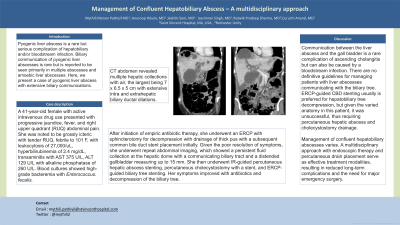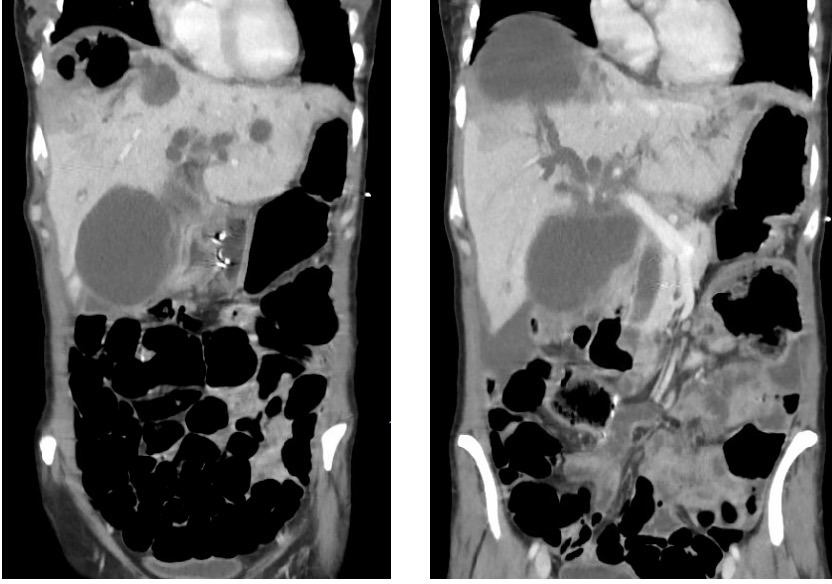Monday Poster Session
Category: Liver
P2500 - Management of Confluent Hepatobiliary Abscess - A Multidisciplinary Approach
Monday, October 23, 2023
10:30 AM - 4:15 PM PT
Location: Exhibit Hall


Mythili Menon Pathiyil, MD
Saint Vincent Hospital
Worcester, MA
Presenting Author(s)
Mythili Menon Pathiyil, MD1, Anuroop Yekula, MD1, Aakriti Soni, MD1, Jassimran Singh, MD1, Rutwik Pradeep Sharma, MD2, Curuchi Anand, MD1
1Saint Vincent Hospital, Worcester, MA; 2Rochester Regional Health / Unity Hospital, Rochester, NY
Introduction: Pyogenic liver abscess is a rare but serious complication of hepatobiliary and/or bloodstream infection. Biliary communication of pyogenic liver abscesses is rare but is reported to be seen primarily in multiple abscesses and amoebic liver abscesses. Here, we present a case of pyogenic liver abscess with extensive biliary communications.
Case Description/Methods: A 41-year-old female with active intravenous drug use presented with progressive jaundice, fever, and right upper quadrant (RUQ) abdominal pain. She was noted to be grossly icteric with tender RUQ, febrile to 101 F, with leukocytosis of 27,000/uL, hyperbilirubinemia of 2.4 mg/dL, transaminitis with AST 375 U/L, ALT 129 U/L with alkaline phosphatase of 260 U/L.
CT abdomen revealed multiple hepatic collections with air, the largest being 7 x 6.5 x 5 cm with extensive intra and extrahepatic biliary ductal dilations. Blood cultures showed high-grade bacteremia with Enterococcus. fecalis.
After initiation of empiric antibiotic therapy, she underwent an ERCP with sphincterotomy for decompression with drainage of thick pus with a subsequent common bile duct stent placement initially. Given the poor resolution of symptoms, she underwent repeat abdominal imaging, which showed a persistent fluid collection at the hepatic dome with a communicating biliary tract and a distended gallbladder measuring up to 15 mm. She then underwent IR-guided percutaneous hepatic abscess stenting, percutaneous cholecystostomy with a stent, and ERCP-guided biliary tree stenting. Her symptoms improved with antibiotics and decompression of the biliary tree.
Discussion: Communication between the liver abscess and the gall bladder is a rare complication of ascending cholangitis but can also be caused by a bloodstream infection. There are no definitive guidelines for managing patients with liver abscesses communicating with the biliary tree. ERCP-guided CBD stenting usually is preferred for hepatobiliary tree decompression, but given the varied anatomy in this patient, it was unsuccessful, thus requiring percutaneous hepatic abscess and cholecystostomy drainage. Management of confluent hepatobiliary abscesses varies. A multidisciplinary approach with endoscopic therapy and percutaneous drain placement serve as effective treatment modalities, resulting in reduced long-term complications and the need for major emergency surgery.

Disclosures:
Mythili Menon Pathiyil, MD1, Anuroop Yekula, MD1, Aakriti Soni, MD1, Jassimran Singh, MD1, Rutwik Pradeep Sharma, MD2, Curuchi Anand, MD1. P2500 - Management of Confluent Hepatobiliary Abscess - A Multidisciplinary Approach, ACG 2023 Annual Scientific Meeting Abstracts. Vancouver, BC, Canada: American College of Gastroenterology.
1Saint Vincent Hospital, Worcester, MA; 2Rochester Regional Health / Unity Hospital, Rochester, NY
Introduction: Pyogenic liver abscess is a rare but serious complication of hepatobiliary and/or bloodstream infection. Biliary communication of pyogenic liver abscesses is rare but is reported to be seen primarily in multiple abscesses and amoebic liver abscesses. Here, we present a case of pyogenic liver abscess with extensive biliary communications.
Case Description/Methods: A 41-year-old female with active intravenous drug use presented with progressive jaundice, fever, and right upper quadrant (RUQ) abdominal pain. She was noted to be grossly icteric with tender RUQ, febrile to 101 F, with leukocytosis of 27,000/uL, hyperbilirubinemia of 2.4 mg/dL, transaminitis with AST 375 U/L, ALT 129 U/L with alkaline phosphatase of 260 U/L.
CT abdomen revealed multiple hepatic collections with air, the largest being 7 x 6.5 x 5 cm with extensive intra and extrahepatic biliary ductal dilations. Blood cultures showed high-grade bacteremia with Enterococcus. fecalis.
After initiation of empiric antibiotic therapy, she underwent an ERCP with sphincterotomy for decompression with drainage of thick pus with a subsequent common bile duct stent placement initially. Given the poor resolution of symptoms, she underwent repeat abdominal imaging, which showed a persistent fluid collection at the hepatic dome with a communicating biliary tract and a distended gallbladder measuring up to 15 mm. She then underwent IR-guided percutaneous hepatic abscess stenting, percutaneous cholecystostomy with a stent, and ERCP-guided biliary tree stenting. Her symptoms improved with antibiotics and decompression of the biliary tree.
Discussion: Communication between the liver abscess and the gall bladder is a rare complication of ascending cholangitis but can also be caused by a bloodstream infection. There are no definitive guidelines for managing patients with liver abscesses communicating with the biliary tree. ERCP-guided CBD stenting usually is preferred for hepatobiliary tree decompression, but given the varied anatomy in this patient, it was unsuccessful, thus requiring percutaneous hepatic abscess and cholecystostomy drainage. Management of confluent hepatobiliary abscesses varies. A multidisciplinary approach with endoscopic therapy and percutaneous drain placement serve as effective treatment modalities, resulting in reduced long-term complications and the need for major emergency surgery.

Figure: CT abdomen
Disclosures:
Mythili Menon Pathiyil indicated no relevant financial relationships.
Anuroop Yekula indicated no relevant financial relationships.
Aakriti Soni indicated no relevant financial relationships.
Jassimran Singh indicated no relevant financial relationships.
Rutwik Pradeep Sharma indicated no relevant financial relationships.
Curuchi Anand: Abbvie – Speakers Bureau.
Mythili Menon Pathiyil, MD1, Anuroop Yekula, MD1, Aakriti Soni, MD1, Jassimran Singh, MD1, Rutwik Pradeep Sharma, MD2, Curuchi Anand, MD1. P2500 - Management of Confluent Hepatobiliary Abscess - A Multidisciplinary Approach, ACG 2023 Annual Scientific Meeting Abstracts. Vancouver, BC, Canada: American College of Gastroenterology.
